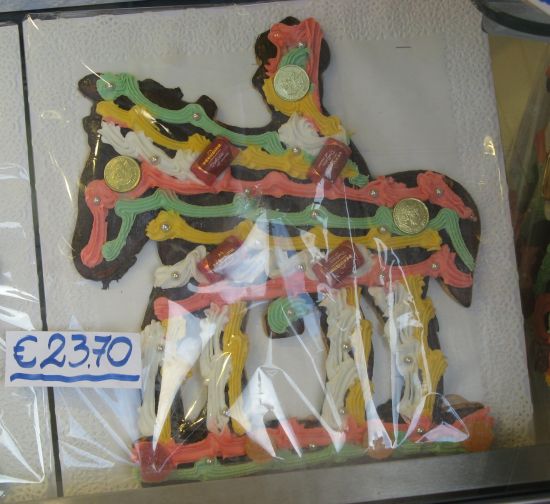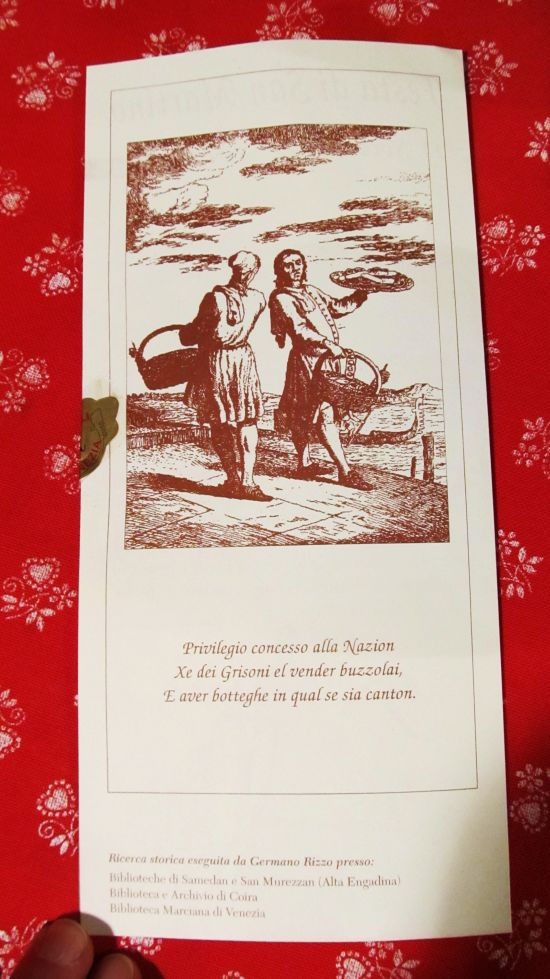
I don’t want Saint Martin’s day 2012 to be associated only with acqua alta and with the words which are being thrown about like fistfuls of gravel: “Disaster,” “Tempest,” “Catastrophe,” and so on.
There is no meteorological event which can get the upper hand of the cookie — the wonderful creation showing Saint Martin astride his horse, sometimes also with his sword upraised ready to cut his cloak in half, translated into dough, colored icing, sprinkles, and chunks of candy that cling to him and his trusty steed.
As I’ve mentioned elsewhere, these cookies come in all sizes, and all calibers of candy, and all are spectacularly overpriced. St. Martin would be ashamed of everybody if he could express himself.
But what’s interesting this year is the bit of history of these confections which I have learned from a leaflet attached to the overpriced cookie Lino gave me. There’s no stopping him: It’s tradition, and if we have to spend the egg-and-butter money for a crumbly San Martino, so be it.
I had assumed that this pastry was some newfangled confection invented by modern bakers looking for a new product for which to charge too much. But no.
Here is what the leaflet said (translated by me):
The custom of giving a San Martino made of shortcrust pastry was introduced and spread, most probably, by the pastrymakers who came from the Canton of Graubunden (Switzerland), who were present in massive numbers in Venice since the 15th century.
They had their own statutes in the scuola (guildhall) adjacent to the church of San Marcuola and near the ancient church of Santa Croce, in the homonymous sestiere, which was subsequently demolished in 1806. (Note: This would have been part of the massacre of Venetian churches, palaces, and guildhalls inflicted by Napoleon after the fall of the Venetian Republic in 1797.)
The archives reveal that more than 80 percent of the pastryshops were run by people from Graubunden, in whose favor the Venetian Senate issued special laws.
With the end of the Republic, due to the adverse political situation, the people of Graubunden were compelled, against their wishes, to leave the city, taking with them and diffusing in the major European cities the traditional Venetian pastry. (I’m all for local pride, but it’s interesting to note that according to this writer, the cookie came to Venice from Switzerland, but left Venice as Venetian. If I were Swiss, I’d object to that.)
The celebration of San Martino coincided with the end of the agricultural labor of the year. To celebrate this important moment, the Venetian patricians organized sumptuous banquets in their magnificent country villas, in which all their workers participated, and it was traditional to conclude the feast with a shortcrust pastry in the form of San Martino.


1 Comment
>to ignore the wailing and gnashing and published or broadcast claims that the city has been driven to its knees.
I think that attitude is frigteningly similar to global climate change denialism. Anybody who thinks Venezia will make it until MOSE completes in 2016*, is mistaken. (* There is but token funding for MOSE in 2013 and that is treasonous. I don’t even believe 2016 any more.)
How many 4-tone acqua alta are needed before the load-bearing walls of the palazzi start to crumble? It will not be a gradual event, when the fall starts, everyday another dozen historic buildings will go down like rows of domino.
Besides the threat of infectious diseases by of flotsam and dead rats that may expel the remaining venexian population (the Salute Feast is just around the corner for a reminder), the worst scenario is earthquakes. The contribution of unusual tides and weather towards seismic activity is now more or less proven, thanks to decades of japanese observations.
Essentially having water over the ground, plus unusually heavier air (higher barometric pressure storm front) compresses the ground and if this phenomenon repeats often, mother Earth will eventually feel like bouncing back and you get an earthquake. I would hate to see what a mere 5.5 richters would do to Venezia while the walls are still wet at the ground level. (The foundation piles can act as ammortizzatore, provided the walls are dry and there is no water on the ground to effect hydro-dynamic knocking.)
Of course one cannot keep the clouds and rain out of the lagoon, but excess adriatic water and the weight it puts on ground, should be blocked. Right now, I would go as far as having 1 or 2 of the lagoon entrances provided with working MOSE dams + locks at “tiger team” speeds and block the other 1 or 2 entrances for good with sunken blockships full of rocks, until finances allow for the full completion of MOSE. Any resulting economic damage would be tiny compared to the full destruction of Venezia.
When MOSE completes there will be some decades of safety to re-consider whether there is a better, more “natural” defence alternative for Venezia, as the political left insists forever.